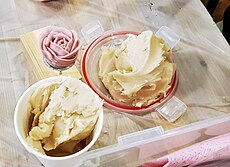Loading AI tools
Bean paste used in Asian cuisines From Wikipedia, the free encyclopedia
Sweet bean paste is a food ingredient used throughout East Asian cuisine, primarily as a filling for sweet desserts and pastries.
| Sweet bean paste | |||||||||||
|---|---|---|---|---|---|---|---|---|---|---|---|
 White bean paste | |||||||||||
| Chinese | 豆沙 | ||||||||||
| Hanyu Pinyin | dòu shā | ||||||||||
| Jyutping | dau6 saa1 | ||||||||||
| Literal meaning | bean sand | ||||||||||
| |||||||||||
The beans are usually boiled without sugar, mashed, and diluted into a slurry. The slurry is then strained through a sieve to remove the husks. The resulting liquid is then filtered and squeezed dry using cheesecloth, and then finally sweetened. Oil in the form of either vegetable oil or lard is usually added to the relatively dry paste to improve its texture and mouthfeel.[citation needed]
Oiled sweet bean paste is mainly found as fillings for Chinese pastries, while un-oiled sweet bean pastes can be used to make tong sui. Japanese pastries use primarily un-oiled sweet bean pastes.[citation needed]
There are several types of sweet bean paste:
There are a number of other pastes used in Chinese cuisine, primarily as fillings for dessert items. Although not made from beans, they share similar usage and are equally popular. They are very similar in flavor and texture to sweet bean paste. These include:
Seamless Wikipedia browsing. On steroids.
Every time you click a link to Wikipedia, Wiktionary or Wikiquote in your browser's search results, it will show the modern Wikiwand interface.
Wikiwand extension is a five stars, simple, with minimum permission required to keep your browsing private, safe and transparent.